Dating Cigar Tax Stamps
A National Cigar Museum Exclusive
© Tony Hyman

Dating Cigar Tax Stamps
A National Cigar Museum Exclusive
© Tony Hyman
Wars require money and willing young men, and the US Civil War was no exception. To raise money, Lincoln’s war time congress taxed a range of items including newspapers, matches, perfume, photographs, medicine, narcotics, canned food, beer, wine, liquor, tobacco and cigars.
Unlike manufacturers of most products, the nation’s 1,000+ cigar factories were more often than not very small, no more than three workers, with a relatively small output, located in small towns and rural areas hard to find or reach by tax officials. As a result evasion of the 1862 law was widespread and an ongoing battle between cigar makers and tax officials began. As a result, in 1863, cigars became one of the first products for which paper revenue stamps were issued to indicate goods upon which taxes had been paid.
1863 first issue
Purchase made possible through support of JR cigars
The first cigar revenue issued in 1863 was 14" long and came in five different colors, green, rose, black, yellow and blue corresponding with the tax per 1000 cigars. The more expensive the retail price of the cigar, the higher the tax. Rates were $3, $8, $15, $25 and $40 (a whopping 4¢ a cigar). All 1863 issues are rare. If you have one of these on or off the box, please contact me.
1864
In 1864 an equally colorful 15 1/2” stamp was issued in the same denominations. When taxes were raised in mid year, new denominations were stenciled, stamped or hand written and signed by the inspector making the changes. This set is widely available to collectors today because excess copies were sold decades ago to the collecting market. They are rarely seen on boxes, however. Please contact the National Cigar Museum if you find one on a box.
1865 Lincoln assassination issue
Lower stamp not in the NCM collection
The rare 1865 revenue issue is unique. Though mostly plain, a very short lived version honored the recently assassinated President Lincoln with two portraits on a mourning black stamp. Most important, the 1865 issue was the first to reflect new IRS regulations requiring all cigars to be packed in boxes of 25, 50, 100, 250 or 500 cigars, the standard sizes in international commerce. Inspectors were no longer required to hand sign the stamps. This issue is rare on or off boxes in any denomination, especially 250 and 500. Top is a partial view, about half the full stamp. Please contact the National Cigar Museum if you find one of these loose or on a box.
1868 to 1869
The short-lived issue of 1868 is another you will seldom find on a box. Note the cancelation stamped on the 100; this is the first issue to mandate rubber stamp cancellations rather than hand written signatures. The 100 is approximately 15” long. When used, all these early issues wrap onto all four sides of a box.
1866 to 1868
The revenue issue of 1866 was the first stamp to be used for more than one year, lasting two, until July of 1868. Issued in the standard five denominations, only the 100 turns up with much regularity on boxes. The 1868 stamp used on imported cigars is very similar to the distinctive brown issue, but the word “imported” replaces “100 cigars.”
1869 to 1872
The mid-1869 issue was used until mid-1872. The 25 denomination was vermillion (red orange) until 1871 when it was changed to black. The 1869-72 issues are seldom seen on a box. Like earlier denominations they wrap onto all four sides of a box. The 50 shown here is not in the Museum collection. If you have a loose 50 denomination, please contact the Cigar Museum.
1872 to 1875
The issue of 1872 was used until the revenue Act of March 3, 1875, ordered a new series. The majority of cigar boxes in the 1870’s held 100 cigars so that is the most common denomination. As with all previous issues, stamps for boxes of 250 and 500 are almost never seen loose or on boxes. The 50 is found with two different portraits, that of Fessenden for the first two years, Waite during the last.

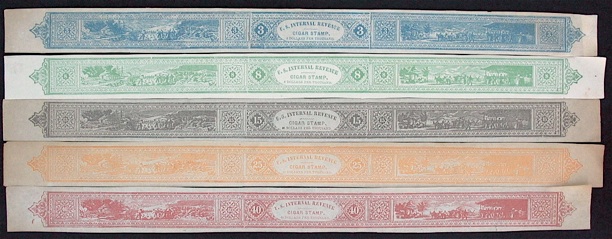
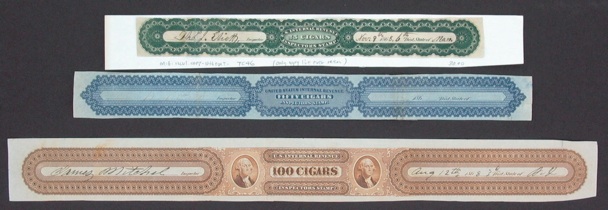
1878 to 1883, 1883 to 1898, 1898 to 1901, 1901 to 1909
A NOTE ABOUT CANCELLATION
Stamps were required to be cancelled. The form of cancellation was specified in IRS rules.
Standardized rubber stamp cancellations were first allowed in the 1870’s and remain permitted as long as stamps are used.
If you know where to look, reading cancelation dates on light or blurry imprints is a lot easier.
1875 to 1878
The last of the pre Golden Age stamps appeared in 1875 and was used on boxes until it was replaced with an all new style and design in 1878. This issue is frequently found with readable rubber stamped dates. The larger denominations are 16” long. The three smaller denominations wrap onto four sides of a cigar box. Like all previous issues, the large denominations are almost never seen loose or on boxes. Large boxes were flimsier and seldom survived.
1878 to 1883, 1883 to 1898, 1898 to 1901, 1901 to 1909
Box of 25
1878 to 1883, 1883 to 1898, 1898 to 1901, 1901 to 1909
Note different typeface used to spell “one hundred cigars” in the center of the stamp.
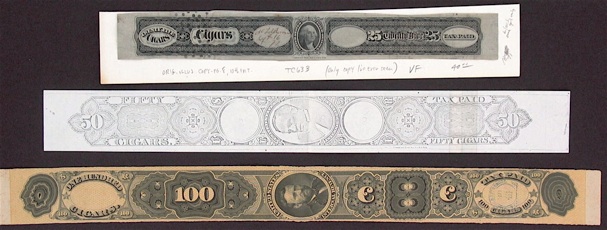

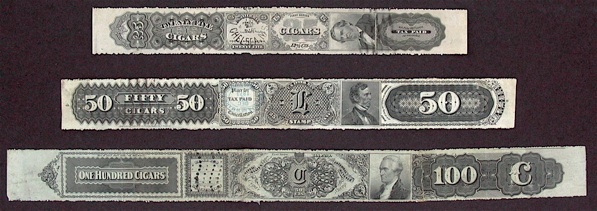

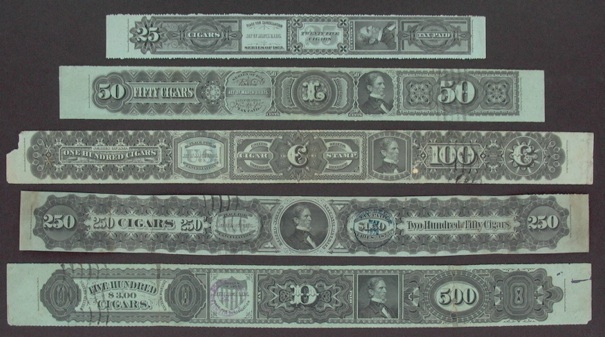
THE 2nd REVOLUTION IN STAMP DESIGN IS IN 1878.
1878 marks an important design and philosophy change. This design was unusual as it was used for three decades (until 1910). After 1878 no portrait except Henry Clay appears on a cigar stamp. Taxes went up or down in 1883, 1898 and 1901 but only the date of the law and its location on the stamp was changed. This 1878/1883/1898/1901 series marks “The Golden Age” of cigars and cigar packaging.
Retail clerks of the Golden Age took seriously the CN wording demanding destruc-tion of the tax stamp. Since stamps are often damaged, it is worth learning exactly where to look to tell them apart even when most of the stamp is missing.
Finding one of these 1878/1883/1898/1901 stamps on a box should alert you that you may have a collectible box; it does NOT in and of itself mean you have a rare box. During the 32 years they were used, tens of thousands of companies pasted them on 2,000,000,000 boxes of cigars. A few cigar companies packed 100,000+ boxes a year.
THE FIRST REVOLUTION IN STAMP DESIGN IS IN 1869.
The issue of 1869 ends the use of color coding the five denominations. In a cost cutting move, subsequent tax stamps are all printed in black ink. Color coding returns in 50 years when World War One causes tax to be levied on retail price.
1891 to 1898, 1898 to 1901, 1901 to 1909 Salesmen’s samples
Salesman sample size boxes of 12 and 13 were first permitted in 1891, requiring two new stamp denominations. A little over 10” long, they dominate the small boxes to which they are applied.
The issues of 1891, 1898, and 1901 are very similar, with only the date changed. Every box of 12 or 13 cigars dates after 1891. They were particularly popular from 1901 until 1910 after which boxes of 10 became legal.
1879 to 1883, 1883 to 1898, 1898 to 1901, 1901 to 1909
Box of 200
In 1879, boxes of 200 became the first new size box to be permitted since 1865 when boxes were restricted to 25, 50, 100, 250 or 500 cigars. Like other denominations, its design remained the same through the legal changes of 1883, 1898 and 1901. Few companies packed in boxes of 200
1883 Tax Rebate Stickers
Pictured are two of the different stickers issued by both the IRS and large cigar factories in 1883, following a rare tax reduction in March of that year. All boxes that had paid the higher 1878 rate but hadn’t left the factory by May 1st were eligible for a rebate. Small operations used the IRS issue on the left. Large companies with huge inventories printed their own. Stamps such as these assisted in inventory and positively identify a box as leaving the factory in 1883, since companies rarely paid taxes very far in advance.
1910 to 1915
The 25’s and 50’s were shortened to 8” so they stretched from the back, across the top, and down the front of a box, but no longer wrapped to the bottom. There distinctive stamps are the last long cigar strip stamps (a strip stamp is a horizontal), and marks the Late Golden Age, the years just before World War One. All denominations picture Clay. The 12, 25, 50, 100 and 200 were printed in black ink on various shades of blue-green paper. There does not seem to have been a 13 or 500 issued in 1910, but previously unrecorded tax stamps still turn up. I’ve personally found three in the last five years, including the two below.




1910 and 1914 large denominations
.
There seems to be disagreement among the revenue stamp fraternity regarding the what and when of large denomination (200, 250 and 500) stamps, specifically which were and which weren’t issued in 1910, 1914, 1916, 1917, and 1926 and what overprints exist on them. All large denominations dated 1910 or later are scarce and I’d like to hear from you if you have or know about them.
1916
The 1916 cigar stamp was a radical departure from previous strips in that it was issued only in 25, 50 and 100 denominations, each the same 3 3/4” size and design, and there was no portrait. Note the dual 1909 and 1916 dates at the bottom center. This particular issue lasted only one year, but the size becomes standard for all stamps on boxes of 20+ cigars until stamps are discontinued in 1959.
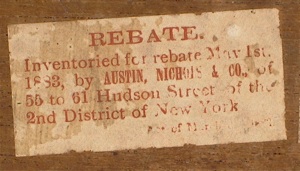

A NOTE ABOUT CANCELLATIONS:
A box of cigars was required to apply a tax stamp when it was shipped out of the factory or displayed open with contents individually for sale. Early laws specified tax stamps be hand cancelled when purchased. Golden Age laws required cancellation by rubber stamp after the stamp was affixed. Starting in 1910, the preferred method of canceling became the two-line machine perforated cancel.
The form was set by law, remained constant as long as stamps were used, and is easy to read. The top line contains the Factory number, tax district and state, the three bits of info separated by a centered dot. The bottom line indicates the month, day and year the stamp was applied, each number separated by a dot. The Class A stamp above clearly tells you the cigars were made in Factory 550 located in the first tax district of Pennsylvania, and was cancelled October 6th, 1927. Single digit days are preceded by a cross rather than a zero.
Those last two digits can often be read even on severely damaged stamps. For example, each number is 3 holes wide and 6 high but all you would need to see is a hole in the lower right corner to know the number was a 1 or a 2, the only numbers that use that hole. Be alert for dates printed upside down, reversed or double-struck.

1932 - 1942
to date a box to the exact year it left the factory. In 1932 a “Series number” was added to the date line which now read “ACT OF 1926 SERIES 102”. “Series 102” represented 1932, “Series 103” was 1933, etc. This system was used until 1955. The last Series number, 125, was printed for an additional four years until 1959 when revenue stamps were no longer required on cigar boxes. Denominations with heavy demand (25 and 50) were printed with the series number. Those with less demand (12, 13, 200, 250 and 500) were usually dated 1926 with the series overprinted in either black or red as needed. A 20 was added in 1928 and is the only stamp to carry that date. During the 1930’s, approximately nine in ten cigars sold in the U.S. were priced at 5¢ or less, so most boxes will have an orange colored Class A stamp. The color of Class A stamps was changed to violet in mid 1940. Both vertical and horizontal strip stamps read 1926 until 1942.
Series numbers are an excellent way of dating boxes. Simply add the last two digits of the series to 1930 and you know the date. A 1926 issue with no series number dates between 1926 and 1932.
1942 - 1959
Series numbers usually changed in the Spring so you will find cancellations that are off by a year from the Series number. The last Series to be printed on stamps was Series 125 (1955) which was used for four years.
1917 to 1926, 1926 to 1932
Orange Class A cigars were to be sold for not more than 5¢ each, and are by far the most common revenue stamp.
Green stamped Class B cigars sold for 6¢ to 8¢. Cigar boxes holding 20 cigars were added to the approved list in 1928 and the stamp is so dated.
Dark blue stamps were on boxes of Class C cigars selling for 8¢-15¢.
Claret stamped Class D cigars were 15¢ to 20¢.
Brownish orange identifies the highest Class E cigars, those selling for more than 20¢.
Cancellations have always been the best way to accurately date a box. Note the stamped 1919 cancellation on the Class E and the increasingly popular perforated cancel on three others. The top line contains the factory number, tax district and state, the info separated by a centered dot. The bottom line is the month, day and year the stamp was applied, each number separated by a dot. When the first number in the pair is a zero, a cross is used. Those last two digits can often be read even on severely damaged stamps. Watch for dates printed reversed or upside down (like the Class C). Can you read the 12-20-21?
The 1917 horizontal strip stamps were issued in 12, 13, 25, 50, 100, 200 and 250. The 1926 stamp was issued in the same denominations except the 12. Color coding remains the same. Bottom line reads “ACT AND 1926 SERIES” until 1932 when the bottom line reads “ACT OF 1926 SERIES 102” with the serial number changing annually until 1955 (series 125).
THE 3rd REVOLUTION IN STAMP DESIGN IS IN 1910.
The 1910 series marks the end of “The Golden Age” of cigars and cigar packaging. Stamps are shorter and thinner, and now wrap only on three sides of a box, usually top, front and back. The issue of 1910-1915 is easy to recognize at a distance.



THE 4th REVOLUTION IN STAMP DESIGN IS IN 1916.
Striking changes take place in cigar tax stamps in 1916. Most obvious is that for the first time all denominations become the same size, a distinctively short 3 3/4” which is pasted only on the top and front of a box. Between 1916 and 1942 cigar tax stamps drop Clay’s portrait making it easy to date boxes in the 1920’s and 30’s at a glance. QUESTION: Short horizontal tax stamp? No portrait? ANSWER: 1916-1942.
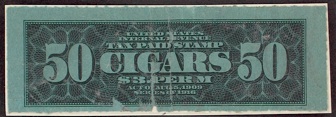
SMALL CIGARS & SMALL DENOMINATIONS
Two types of cigar stamps were distinctly different: those for small cigars weighing less than 3 pounds per thousand and those used on small packages of regular large cigars.
1879 to 1883, 1883 to 1897 cigarette stamp used for small cigars
Only the dates differ between the two issues. Illustrations not to scale. Red overprint indicates tax law change of 1897.
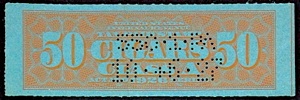
THE 5th REVOLUTION IN STAMP DESIGN IS IN 1917
The size and overall design remain the same as 1916. What’s new? World War One, which caused Congress to return to the Civil War system when cigars were taxed by their selling price and stamps were color coded.
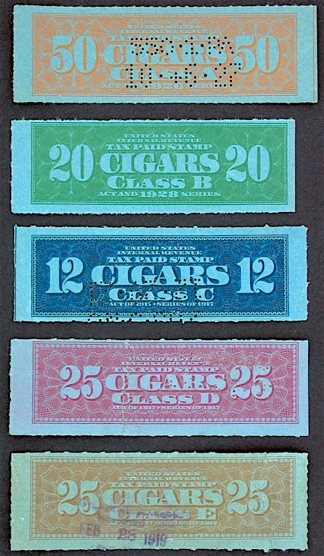
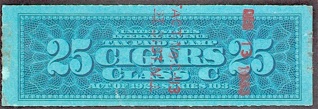

THE 6th REVOLUTION IN STAMP DESIGN IS IN 1942.
The size is about the only thing that remains the same when World War II taxes cause a complete redesign. The colors disappear and Clay’s portrait returns as stamp production was completely overhauled. To cut waste and cost tax officials finally become practical with their stamp design. Starting in 1942 (Series 112) blank base designs were created for both the vertical and strip stamps, enabling tens of millions of identical blank stamps to be economically printed in mass runs. The denomination, tax class and series was overprinted in black as needed. Stamp waste was cut to almost nothing. The design, once again adorned with Clay’s portrait, was used until 1959, when stamps were discontinued.
1897 to 1901, 1901 to 1910 small cigar stamps
Small cigars 50 and 100 stamps were issued in 1897 to replace cigarette stamps. When the law changed in 1898 the 1897 issue was overprinted. The stamp was reprinted with a new date in 1901.


1897 to 1959 stamps for small packs of small cigars
1897-1901 1901-1910 1910-1920 1920-1926 1926-1932 1932-1959
In July 1897, Small Cigars became their own category and packs of 10 & 20 became legal. Vertical 10 & 20 stamps for cigarette-like cigars were issued for the next 60 years. Starting in 1910 an 8 was added. Note dates at top and bottom and the addition of a series number starting in 1932. The red print on the 1901 is an example of the 1st machine cancellation (factory no., tax district and date). The issue of 1920-1926 is the 2nd (and last) undated revenue stamp since 1864. Read cancellations closely as they often include dates.
1910 to 1959 stamps for packs of 3, 5, 7 and 10 large cigars
1910-1917 1918-1926 1926-1932 1932-1942 1942-1959
1910 is the first year full size cigars were legally permitted to be sold in boxes or packs of 5 or 10 like cigarettes and small cigars. After 1926 stamps were also issued as 3’s and 7’s.
The 1 3/4” tall 1910 stamps are dated “Act of Aug. 5, 1909” at the top and “Series of 1910” at the bottom and are easily recognizable by their unique red ink. This issue was frequently overprinted when the law changed in 1917. This is the easiest stamp ever to identify at a glance. Any box or pack with this stamp dates in the teens. The 1917 to 1926 issue is the 1st undated vertical revenue stamp. From 1926 to 1942, all stamps read “Act 1926” at the top, but after 1932 they also have a “Series Number” at the bottom.
You may occasionally find boxes of 1, 2, 3, 5 or 10 full size cigars sold before 5 and 10 packs became legal in 1910. Factories packed these small boxes inside larger boxes of 100, 200 or 250 upon which tax stamps were placed. These small boxes are marked on the bottom as having come from a larger legal package.
End of the Tax Stamp Era
After June of 1959, the government quit providing stamps for any tobacco product. To ease the book-keeping burden, Federal tax forms were permitted to be filled out semi-monthly.
Rubber stamping on the bottom of this box reflects law changes that made stamps optional after 1956. This is the bottom of a box produced by Los Angeles based Kernels, perhaps the only cigar company in America regularly packing their output in boxes of 20. They may have been the only company permitted to use two 10 stamps, permission granted because it was easier for the government not to print 20’s when so few companies used them. Kernels was one of the first cigar companies to convert to paying tax based on shipping figures rather than by buying stamps.
I’ve handled ten thousand + 1950’s boxes; this is the only example of that imprint I’ve seen.




1ST YEAR OF ISSUE FOR
CIGAR STAMPS
3 1918 12 1891 100s 1897
5s1897 13 1891 100 1865
5 1910 20s1897 200 1879
7 1918? 20 1928 250 1865
8s 1910 25 1865 500 1865
10s1897 50s1897
10 1910 50 1865 s = stamp for small cigars
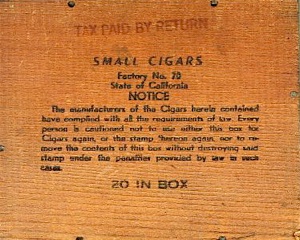
NOTE ABOUT OVERPRINTS
When a stamp issue is replaced thanks to new taxes, the government overprinted older stamps for a few months until supplies were exhausted and the new stamp available. Overprinting of issues was particularly common in 1898 because large supplies of 1883 were on hand, and the war tax came up quickly. Overprints were also common during the 1930’s when stamps were required to have date changes every year resulting in many seldom used denominations being overprinted onto the 1917 or 1926 stamp. Large denomination stamps frequently have no date other than the overprint.

Purchase made possible through support of JR cigars
Whether labeled “Cigars,” “Cigarros,” “Cigarettes” or “All Tobacco Cigarettes,” if 1,000 of them weighed less than 3 pounds Federal tax officials called them “cigarettes” and taxed them at a lower rate. From 1868 to 1879 cigarette stamps were issued only for boxes of 500. In 1879 and 1883 cigarette strip stamps were issued for boxes of 50 and 100. Small boxes containing 100 small cigars with 14” long 1883 cigarette stamps are seen regularly on eBay, and often have diminutive brand or size names like Ponies, Babies, Midgets, Lady Fingers and the like. The 50 is 10.5” long.







